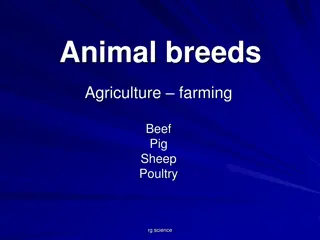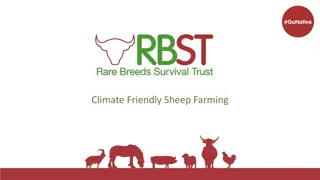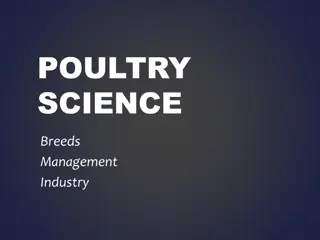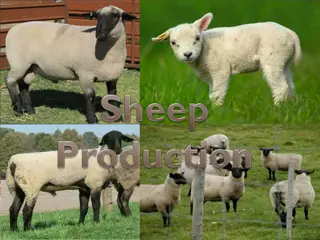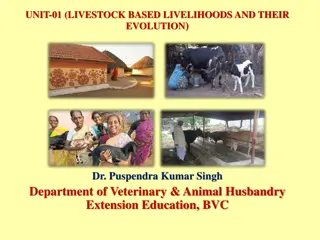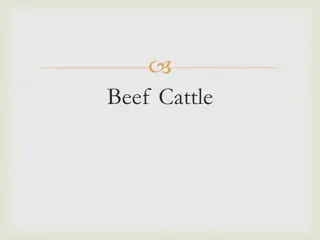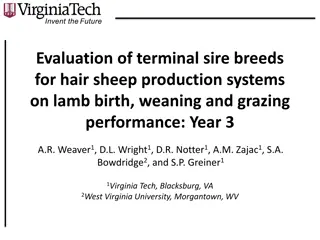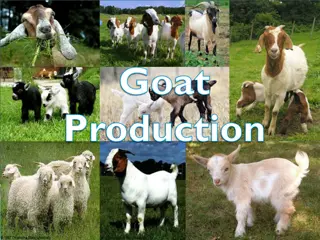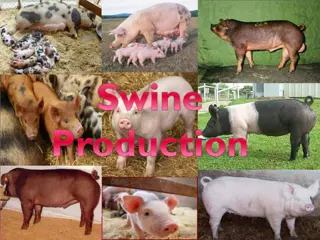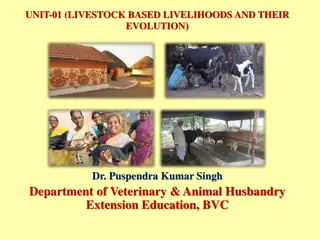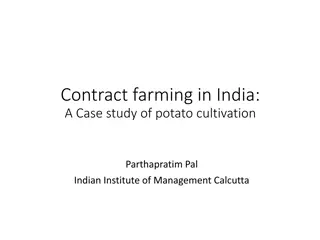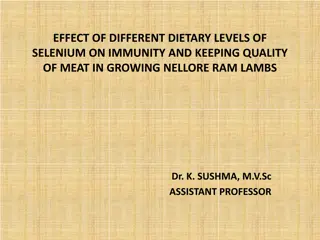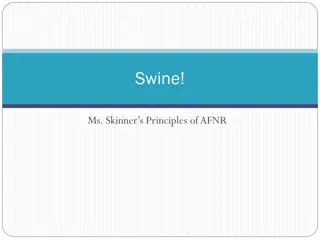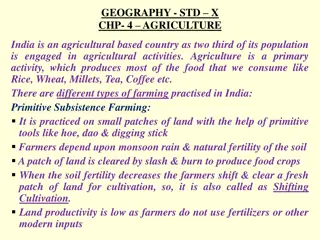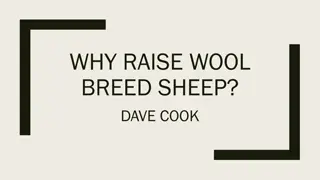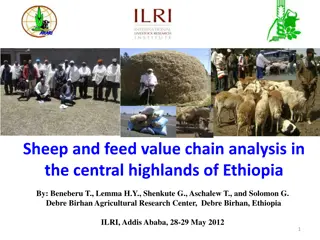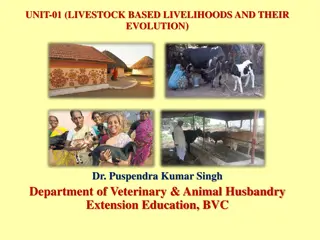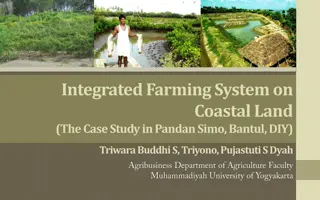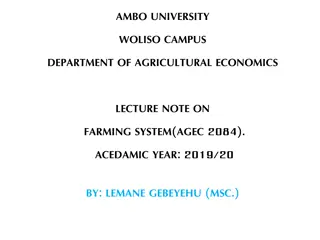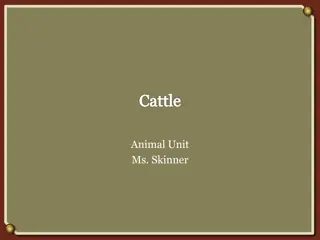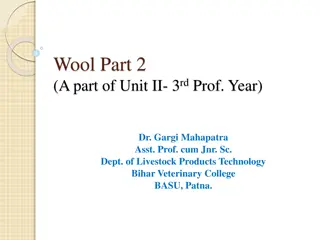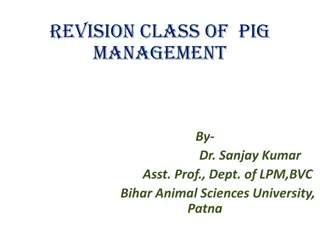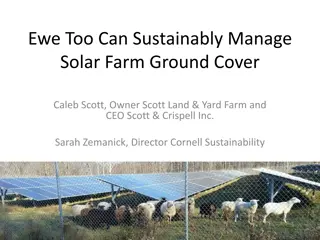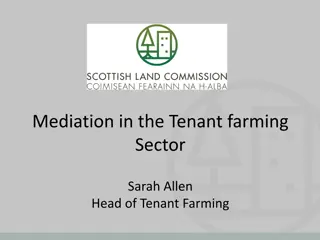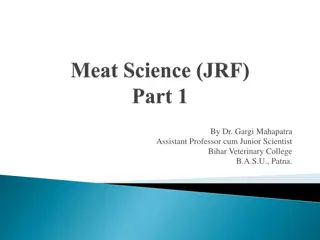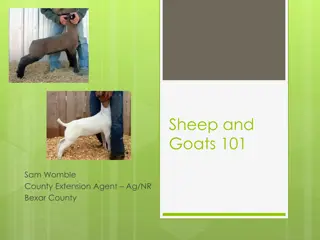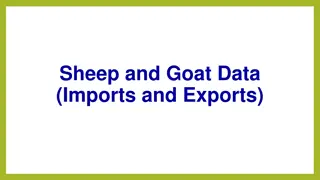Sheep Production: Breeds, Management, Nutrition, and Farming Practices
Explore the world of sheep production, covering common sheep breeds, management practices, nutrition requirements, and farming differences between hill/mountain and lowland regions. Learn about key terms, breeding cycles, gestation periods, and the importance of sustainable sheep/lamb production.
Uploaded on Oct 02, 2024 | 0 Views
Download Presentation

Please find below an Image/Link to download the presentation.
The content on the website is provided AS IS for your information and personal use only. It may not be sold, licensed, or shared on other websites without obtaining consent from the author. Download presentation by click this link. If you encounter any issues during the download, it is possible that the publisher has removed the file from their server.
E N D
Presentation Transcript
Sheep Production
Learning Outcomes You should be able to: Identify and give characteristics of common sheep breeds. Discuss management practices for: handling and housing. optimal animal health and welfare slurry/farmyard manure delivering sustainable and environmentally friendly production systems ensuring quality, safe and traceable food for the consumer Discuss the importance of nutrition and ration formulation to meet the protein, energy and performance requirements at different growth/development stages of sheep. Compare hill/mountain sheep farming with lowland sheep farming Compare early lamb production and mid-season lamb production. Discuss sheep/lamb production through the lenses of out cross-cutting themes: Breeding and Genetics, Technology, Sustainability, Policy and Economics, Health and Safety.
Key Terms Seasonally polyoestrous: Have many oestrus cycles during a set time of year. Flushing: Moving ewes from a low plane of nutrition to a high plane of nutrition prior to mating. Steaming up: Moving ewes from a low plane of nutrition to a high plane of nutrition prior to lambing. Ram: Male Ewe: Female Prolific: Breeds that encourage multiple births. Terminal: Breeds that produce good offspring for slaughter. Polled: Naturally born without horns.
Key information Sheep are short day breeders come into oestrus in autumn. Length of oestrus cycle: 17 days Duration of oestrus: 36 hours Gestation period: 147 days (5 months less 5 days)
Sheep/Lamb Production Sheep farms can be based in hill/mountain regions or on lowland farms. Hill/Mountain farms are less productive as the vegetation is of poorer quality and it is more difficult to make improvements to grazing. Animals are exposed to harsher conditions and so there are less multiple births. Hill/Mountain sheep have smaller, lighter bodies that are in demand in some Mediterranean countries. Hill/Mountain breeds have excellent mothering abilities as they must care for their offspring in poor conditions. This makes them in demand for crossbreeding on lowland farms.
Hill/Mountain Breeds Purebreeds are used in mountain/hill farming to retain characteristics. Used as maternal dams for crossbreeding replacement ewes on lowland farms. Blackface Mountain: Small bodies with long wool and black faces. Hardy. Good mothering ability. Horned. Wicklow Cheviot: Medium size with white faces. Hardy. Good mothering ability. Polled.
Lowland Breeds - Prolific Prolific breeds are used as maternal sires to produce replacement ewes as they promote multiple births. Border Leicester: Long, white wool. Upright ears. Polled. Bluefaced Leicester: Long, white wool. Upright ears. Roman nose. Polled.
Lowland Breeds - Terminal Used as sires to produce lambs for slaughter. Suffolk: Excellent conformation. Short wool. Black head and legs. Polled. Fast growth rates Often used for Easter lamb production. Texel: Excellent conformation. Excellent carcase quality. White face. Slower growth rate Used for mid season production.
Hill/Mountain vs. Lowland Mountain Rough grazing Low stocking rate Low production targets Extensive Single births Purebred Lowland Rotational Grazing High stocking rate High production targets Intensive Twins and triplets Crossbred
Lowland Breeding A mountain ewe whose fertility has declined is brought down to a lowland farm. The more favourable conditions allow the fertility to improve. This ewe will be crossed with a prolific breed. The offspring of this cross will be used as a replacement ewe for the lowland farm. The replacement gets excellent mothering ability from the mountain ewe and gets prolificacy from the lowland breed.
Lowland Breeding This crossbred replacement will be crossed with a terminal breed each year it is on the farm. The prolificacy from the original sire encourages multiple births (quantity). The terminal breed increases the carcase quality of the lambs when sold for slaughter (quality). If planning to breed for the Easter market a Suffolk can be used. If planning to breed for mid-season a Texel can be used.
Ewe Replacements When selecting replacements farmers should look for: Prolificacy Good Conformation Good BCS Health Good teeth, feet and legs Good udder with functioning teats
Ram selection When selecting a ram for breeding a farmer should look for: Performance testing Progeny testing Pedigree Good Conformation Good BCS Good teeth, feet and legs
Easter vs. Mid season lambs Easter Ready for the Easter market better price Mid-season Lower price Price Lambs born December-January Mated July-August Breeding Out of season Higher Cost Feed More concentrates Higher Cost March-April September-October Normal breeding cycle Utilise grass
Flushing Moving ewes from a low plane of nutrition to a high plane of nutrition prior to mating. Four weeks after mating ewes should be returned to a maintenance diet. Benefits: Increases ovulation rates Better implantation More regular heats Increases lamb numbers
Breeding out of Season For Easter lamb production sheep must be bred in July- August in order to have lambs ready. Sheep do not naturally begin their oestrus cycling early enough and so they must be brought in to oestrus. Two methods: Sponging The ram effect When breeding out of season a smaller ewe:ram (10 : 1) ratio is used.
Sponging A progesterone soaked sponged is inserted into the ewes vagina. It is left for 12-16 days. The sponge is removed. The ewe receives a PMSG injection. The ewe can be mated 1-2 days later.
The ram effect The ram must be removed from the ewes for six weeks prior to mating. Reintroducing the ram suddenly can cause ewes to come into oestrus. This can be used to breed out of season or synchronise breeding without using sponging.
Marking A raddle and ram crayons can be used to mark ewes that have been mated. This allows the farmer to keep track of ewes in lamb and identify if ewes have been mated but failed to conceive which can be an indicator of poor fertility. Lighter colours are used at the beginning of the season and darker colours later in the season.
Scanning 80 days after the ram has been turned out the flock can be scanned. This can identify barren ewes Can use this information to cull animals. It also determines if the ewe is pregnant with single or multiple lambs Can separate based on number and manage feeding regime (to prevent twin lamb disease).
Steaming up Moving the animal from a low plane of nutrition to a high plane of nutrition prior to giving birth. Begin steaming up 6-8 weeks prior to lambing. Begin giving 100-200g per day and increase by 100g every week in order to reach 500-750g per day by lambing time. Increases the BCS in order to prevent twin lamb disease.
Lambing Ewes should be placed in lambing pens. Housing prevents predation. Good hygiene should be maintained in housing. Steaming up should be used to increase BCS to 3 in order to prevent twin lamb disease. A heat lamp can be used if temperatures are low to prevent chill/hypothermia. Sheep should lick the lamb promotes bonding and stimulates circulation. Remove mucus from nose and mouth clears airways. Dip the navel in iodine Prevent navel ill. Ensure sufficient colostrum is received Prevents infections.
Fostering A farmer can use fostering to get a ewe to accept a lamb that is not her own. Wet fostering: Rub birth fluids from the ewe on the foster lamb and allow the ewe to lick the lamb. Fostering sprays: Spray the lamb and the nose of the ewe. Skin a dead lamb: If a ewes offspring dies attach its skin to the foster lamb. Fostering crate: Hold the ewe in place to prevent her from injuring the lamb, allows the lamb to suckle. Dog: Place a dog tied up near the pen. The ewe will become protective of the lamb and is less likely to reject it.
Post-lambing Ewes should be kept on a high plane of nutrition to ensure good milk production and prevent a large drop in BCS. Cal Mag should be used to prevent calcium deficiency (milk fever) and magnesium deficiency (grass tetany). Once available sheep should graze grass rotationally. Creep grazing can be used to allow lambs fresher grass but still providing access to ewes for suckling. A creep feeder allows lambs to receive concentrates without allowing ewes access to them. This is particularly important in Easter lamb production as it ensures they reach their target weight on time.
Culling animals Ewes may be culled from the flock for the following reasons: Reduced fertility Lambing difficulties Lameness Chronic infections e.g. mastitis
General Husbandry Dosing sheep prevents the build up of endoparasites in the flock. Dipping involves placing the sheep in a solution that kills external parasites. In summer dipping helps to prevent fly strike. In winter dipping helps to prevent sheep scab (caused by mange mite). Dagging is the removal of hair from around the tail and anus. This helps to prevent fly strike. Docking is the removal of part of a lambs tail in order to shorten it. This helps to prevent fly strike. Footbaths can prevent foot rot which causes lameness. Shearing involves removing the wool from a sheep to prevent overheating during summer. This also helps to prevent fly strike.
In-wintering In-wintering means to move animals into housing rather than leaving them outdoors over winter. Reduces predation Reduces poaching Lower mortality Better supervision and management around lambing time
Improving Outputs Selecting appropriate breeds for targets. Effective disease control reduces losses. Improved management and feeding around mating and lambing time reduces mortality.
Breeding and Genetics Selecting breeds with appropriate traits improves outputs. Crossbreeding to introduce hybrid vigour helps to improve the genetic merit of the flock.
Technology All animals should be tagged so that meat is traceable. Flocks must be registered and farmers must complete an annual sheep census. Grassland Management technologies can be used to more efficiently monitor and plan grazing to improve outputs.
Sustainability The Sustainable Beef and Lamb Assurance Scheme (SBLAS) is a Bord Bia Scheme to ensure farmers undertake sustainable practices while producing meat. This reduces the negative impact farms have on the environment.
Policy and Economics Lowest income per hectare of the main farm enterprises. Increases in recent years due to schemes. Limited use of hill and mountain land if farmers stopped farming sheep. Food Wise 2025 identifies new markets to be explored for exports. Sheep Welfare Scheme involves farmers taking extra measures to improve animal health and welfare.
Health and Safety Care should be taken when handling or moving animals. PPE should be worn and care taken when handling any chemicals. Good hygiene helps to prevent infections of both animals and humans. Care should be taken when using any machinery.



